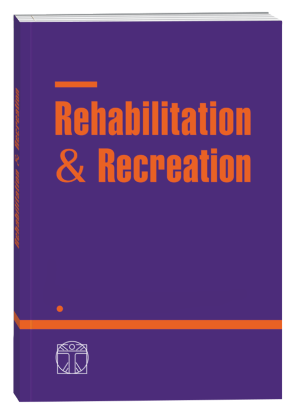PHYSICAL ACTIVITY OF SENIORS AS A CONDITION OF HEALTH AND GOOD QUALITY OF LIFE
DOI:
https://doi.org/10.32782/2522-1795.2022.12.15Keywords:
health, lifestyle, physical activity, agingAbstract
The aging of the population of Europe and Poland is probably the most important health and socio-political challenge in the coming years. In 2050, people aged 60-79 are expected to make up a quarter of the entire population of the European Union. Maintaining the appropriate level of health, independence and independence of the elderly becomes a great challenge. This is not only a public health challenge, but also a huge socio-economic problem. A typical situation in old age is the occurrence of several diseases at the same time. In addition, the situation is complicated by the procedure of a number of degenerative changes affecting almost all systems and functions of the system, deteriorating the possibility of functioning and rehabilitation. Taking up issues related to seniors becomes important for at least several reasons. The most important are: the increasing number of elderly people, the widespread cult of a man who is capable and independent in terms of material conditions (completely different from the geriatric reality), the need to educate professionals to help or support those in need, and the need for mental changes in society regarding the aging process and old age itself. It should also be remembered that the effects of exercise in the elderly are relatively short-lived. A break in training for several months causes a loss of beneficial adaptations. The problem of physical activity, especially among the elderly, is complicated by the outbreak of the COVID-19 pandemic. The temporary ban on leaving the house, the need to keep social distance, closing green areas, senior clubs, fitness clubs, etc., drastically limited the level of physical activity of seniors. The uncertain period of ending the pandemic, as well as the psychological consequences, incl. fear of leaving home, even after its completion, makes the current trends in physical activity in old age difficult to predict. That is why systematic, moderate physical activity of the elderly, providing many health benefits, is so important. It results in successful – healthy aging as it contributes to delaying and minimizing involution processes, maintaining health and functional and functional independence in both somatic, mental and social dimensions.
References
Григус І.М., Хома О.В. (2022). Оздоровчо-рекреаційна рухова активність у профілактиці хронічних неінфекційних захворювань чоловіків похилого віку в умовах карантинних обмежень. Реабілітаційні та фізкультурно-рекреаційні аспекти розвитку людини=Rehabilitation & recreation. 11. 163-172.
Barankiewicz J. (1998). Leksykon wychowania fizycznego i sportu szkolnego. Wydawnictwa Szkolne i Pedagogiczne, Warszawa. 479 s.
Borowiak E., Kostka T. (2006). Influence of chronic cardiovascular disease and hospitalization due to this disease on quality of life of community-dwelling elderly. Quality of Life Research. Vol. 15, No. 7, 1281-1289.
Diachenko-Bohun, M., Hrytsai, N., Grynova, M., Grygus, I., Skaliy, A., Hagner-Derengowska, M., Napierała, M., Muszkieta, R., & Zukow, W. (2020). Historical Retrospective of the Development of Scientific Approaches to Health-Saving Activity in Society. International Journal of Applied Exercise Physiology, 9(1), 31-38.
Drabik J. (1999). Aktywność fizyczna w kształtowaniu zdrowia człowieka – korzyści i zagrożenia. Wychowanie Fizyczne i Sport, nr 4. 121-123.
Grygus I. (2017). The role of physical activity in the rehabilitation of patients suffering from mild persistent bronchial asthma. Physical Activity Review, 5: 155-166.
Kozdroń E. (2008). Rekreacja ruchowa jako składnik zdrowego stylu życia. Minimum aktywności ruchowej. Podstawy teorii i metodyki rekreacji ruchowej. Podręcznik dla instruktora rekreacji ruchowej, [red. E. Kozdroń]. Towarzystwo Krzewienia Kultury Fizycznej, Warszawa.
Kostka T. (2010). Aktywność fizyczna u osób w podeszłym wieku. Podręcznik Polskiego Forum Profilaktyki pod redakcją prof. dr. hab. Piotra Podolca. Medycyna Praktyczna, Kraków.
Kostka T., Drygas W., Jegier A., Zaniewicz D. (2009). Aerobic and anaerobic power in relation to age and physical activity in men. Int. J. Sports Med. Vol. 30. 225-230.
Kulik TB. (2002). Koncepcja zdrowia w medycynie. Zdrowie publiczne. Kulik TB, Latalski M (red). Czelej, Lublin.
Heszen T., Sęk H. (2012). Behawioralne uwarunkowania zdrowia i choroby. Psychologia zdrowia. Heszen I., Sęk H. (red). PWN, Warszawa.
Mahlovanyy A., Grygus I., Kunynets O., Hrynovets V., Ripetska O., Hrynovets I., Buchkovska A., Mahlovana G. (2021). Formation of the mental component of the personality structure using physical activity. Journal of Physical Education and Sport, Vol 21 (Suppl. issue 5), 3053–3059.
Marchewka A. (2012). Aktywność fizyczna – oręż przeciw niepełnosprawności osób w starszym wieku. Fizjologia starzenia się. Profilaktyka i rehabilitacja. Red. Marchewka A. i wsp. Warszawa; PWN.
Marcinkowski J. (2004). Aktywność fizyczna człowieka ważnym czynnikiem w kształtowaniu postaw prozdrowotnych. Aktywność fizyczna potrzebą twórczego życia, [red. J. Czerwiński]. Olsztyńska Szkoła Wyższa, Olsztyn.
Psaltopoulou T., Kyrozis A., Stathopoulos P. i wsp. (2008). Diet, physical activity and cognitive impairment among elders: the EPIC-Greece cohort (European Prospective Investigation into Cancer and Nutrition). Public Health Nutr. 11(10):1054-1062.
Rottermund J., Knapik A., Szyszka M. (2015). Aktywność fizyczna a jakość życia osób starszych. Społeczeństwo i rodzina, nr 42 (1). 78-98.
Osiński W. (2003). Antropomotoryka. AWF, Poznań.
Downloads
Published
How to Cite
Issue
Section
License

This work is licensed under a Creative Commons Attribution-NonCommercial-NoDerivatives 4.0 International License.











